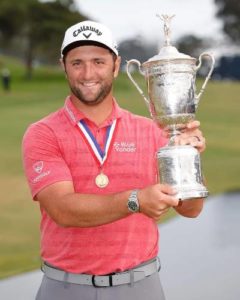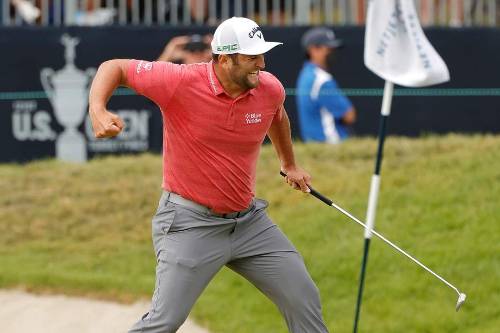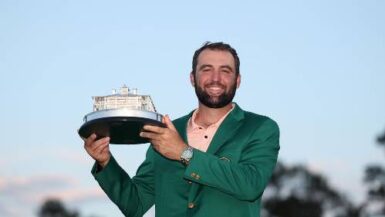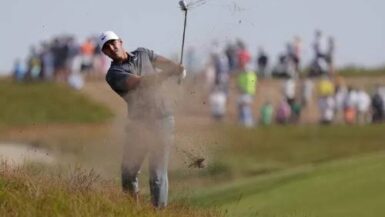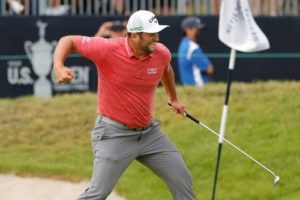
Jon Rahm, who has endured genuine heartache through the Coronavirus pandemic both on and off the golf course found solace, synchronicity, and redemption in the unlikeliest of places – the crucible of U.S. Open golf championship.
Rahm became the first Spaniard to win the U.S. Open after firing a scintillating 4-under 67 to edge South Africa’s starcrossed Louis Oosthuizen by one stroke. Rahm birdied the final two holes to race past Oosthuizen, who inexplicably drove into a penalty area on the penultimate hole, the de facto margin of victory. Rahm becomes the fourth Spanish major golf champion, joining five-time major winner Seve Ballesteros, two-time Masters winner Jose Maria-Olazabal, and current PGA Tour star Sergio Garcia.
It was redemption because just two weeks ago, a devastated Rahm was led off the 18th green of Muirfield Village golf course by Tour officials after being informed he had failed a Covid-19 test and would be required to withdraw.
He had built a six-shot lead going into that final round.
Rahm endured another full week of isolation. He even had to stay apart from his own family, in another section of his home, away from his wife, newborn, and his parents who flew in from Spain to meet their new grandchild. He couldn’t even play golf, instead practicing on a simulator for a week.
But now just two weeks later, at the first competition upon his return, he is a newly-minted major champion and the toast of all Spain – even more so than their beloved La Furia Roja national soccer team.
Starting the day at 2-under, three shots behind co-leaders Oosthuizen, Mackenzie Hughes, and Russell Hanley, Rahm birdied the first two holes at Torrey Pines flawlessly – two 300+ yard drives split the fairways and his approaches were to five feet and five inches respectively.
That’s how to announce your presence on Championship Sunday. He jumped to 4-under before the leaders had time to put their golf gloves on.
After air-mailing the green with a 6-iron at the tiny, but testy par-3- third, Rahm made a brilliant up and down from the collar of rough on the canyon’s edge. A bogey at the fourth dropped him back to 3-under where he stayed until the par-5 ninth where he got the break of the tournament.
Rahm double-crossed his tee shot, perhaps his only really bad miss of the day, but the ball did not go out-of-bounds. Instead, it instead nestled in a TV compound area, from which he got a free drop with a clear view down the fairway. A long iron back to the fairway and a grateful “Thank you, Sir!” to the rules official set up what was supposed to be a simple wedge shot.
A birdie after that tee shot would be like falling through a hole in a privy and coming out smelling like a rose.
But Rahm pull-tugged it. It should have been fifty feet from the cup. Instead it bounced off the top of the bunker, caromed right, found a swale and tracked to within four inches of the cup, nearly holing out on its way by. With a sheepish grin, Rahm had moved to 4-under again. Privy, meet Rose.
It was that kind of day for Rahm. Everything broke his way.
Perhaps that’s where the synchronicity comes in. Rahm and his wife Kelley have always loved Torrey. He proposed marriage to her here. He won his first PGA Tour event here, the 2017 Farmers Open, where he rolled in a twisting 66-foot eagle putt at the 72nd hole a la Tiger Woods on Saturday in 2008. Now he has another Tiger-esque moment at Torrey – not only lifting the trophy, but winning a major at a course on which he has won before as a professional.
“It reminds me a lot of back home; it’s a lot like my home…it resonates with me. Every time we come here, we are happy. We get off the plane, and we say, ‘All right, we are in our spot.”
Still, the back nine started as a dogfight. Four players were tied for the lead and another five were one shot back, six of them former major champions with a total of 14 titles between them.
Then the back nine tuned into carnage.
One by one, everyone fell victim to a crash except Rahm. He was the only player in the final six groups to not card a bogey or worse on the final nine holes.
The adage is true: the tournament doesn’t begin until the back nine on Sunday.
At first it seemed the tournament belonged to Bryson DeChambeau, and not to either Rahm or Oosthuizen. By 2:15 local time DeChambeau had taken the lead, making the turn at 5-under and looking unstoppable. Russell Henley and Mackenzie Hughes had started their free fall down the leaderboard, (they shot 77 and 78 respectively) and even Brooks Koepka, the back-to-back champion from 2017 and 2018 was flailing, four shots behind. Rory McIlroy was barely clinging to hope, and Oosthuizen was only treading water – level par for his day through the ninth.
So Bryson strode to the 11th tee the man to beat, ready to go back-to-back at the U.S. Open like his foil, his nemesis Brooks Koepka just did…
…and then his slide rule broke…or someone kicked the cord out of his computer…or his Jimmy Neutron-ish brain seized up…or his evil twin locked the real Bryson in the trunk of his courtesy car and decided, “There’s a U.S. Open going on! Let’s go and hack at it!” Whatever happened, it was a bogey, another bogey, a double, and a quad coming home, and Bryson fell off the leader board with a resounding thud.
The highlights of that on ESPN will make Koepka quite happy. He might even get a meme out of it. “When the calculator batteries go dead…”
Aside – the fight between the two of them is childish, and I blame Koepka. Brooks is wrong in his pre-tournament press conference when he says the feud is good for golf because it somehow “builds the buzz” and “generates casual eyeballs.” Casual eyeballs are fickle eyeballs, they neither stay, nor generate revenue. Save the trash talk for basketball or boxing. Brooks made loose and unfounded insinuations about Bryson and PEDs, and Bryson stayed classy and – for the most part – ignored him. He gave Brooks a gentle warning about crossing lines and that was it: end of story. Bryson wins that fight on points.
Anyway, Bryson’s supernova left the tournament to Rahm and Louis.
As usual, Oosthuizen was playing well enough to hang around, but not well enough to throw a knockout punch. Yes he birdied the par-5 ninth and the short par-4 10th, but he started leaking oil from there. He bogeyed 11 to drop back to a one shot lead at 5-under to Rahm’s 4-under. Then he spent the next five holes scrambling like old Minnesota Vikings quarterback Fran Tarkenton. With gutsy up-and downs and hair-raising recoveries he was still ahead when Rahm reached the 17th tee.
But while Louis was struggling, Rahm was strong. He was splitting fairways. He had missile command control of his iron play. He just missed three short putts on 12, 13, and 14 or he would have already been ahead.
“After I missed the putt on 14 I turned to Alex [his caddie] and said, ‘Two threes and two fours wins this”….Last time I won here, I finished birdie-eagle, and I knew I could finish strong again. I knew history could get close to repeating itself.”
And that’s exactly what he did. On 17, Rahm hit a 122-yard gap wedge from a fairway bunker to 15 feet above the hole. Rahm rolled in the putt dead center and reeled in the share of the lead that had eluded him for the last 45 minutes.
Better still: He had birdied 18 in all three of the previous rounds.
Rahm hit a gargantuan 333 yard tee shot on 18 dead center leaving him what the caddie called, “a perfect 4-iron” distance to the hole, and it was at that moment that Rahm remembered the golden rule of back nine Sunday major championship golf…
…driest ball wins.
Rahm bailed a bit right and landed in the front greenside bunker. Not taking any chances with his ball headed directly towards the water should he try to hole the shot, Rahm played to a spot will above left of the flag. Again…driest ball wins.
The plan worked to perfection.
“I trusted my read, and as soon as I made contact, I looked up and saw where the ball was going. It was exactly the speed and line I visualized,” he explained. “I told myself, ‘That’s in….That’s in the hole!’ And it went in.”
Oosthuizen still had a chance, though. The man who won the 2010 Open Championship by a record-tying eight shots was still out there and was particularly hungry for this win.
Five consecutive runner-up finished in majors will do that to you…more so when it’s a Grand Slam of second place finishes. That’s a left-handed bit of history there. And cheerful demeanor or no, Louis is weighed down by this, no doubt. He might not say it, but it gets harder each time.
So Louis strode to the short, birdie-able, but still dangerous 17th hole one stroke behind Rahm with the short par-5 18th – the easiest hole in the entire 120 year history of U.S. Open Championship golf – still to come.
Oosthuizen had the entire United States of America to his right and the boundless Pacific Ocean on the left. So he hit it in the hazard, took a penalty drop and failed to get up-and-down.
What was that we said just a few paragraphs ago? DRIEST BALL WINS.
“I could see early on what was happening with the leader board at the end and knew that I need to push at the end to do something,” Oosthuizen admitted. “I took the tee shot on at 17, and I knew it was a crucial hole for me to take it on and give myself a birdie opportunity. I didn’t pull it off, but standing on that tee again, I’ll probably do the same thing, taking a driver and taking the shot on.I feel like I had my shots, I went for it, and that’s what you have to do to win majors. Sometimes it goes your way,and other times it doesn’t.”
Louis’s tee shot on 18 landed in the rough with no chance to get home. He managed to get it to 69 yards, a quirky distance to gauge and was only able to get to within eight feet, making his closing birdie academic.
Rahm has become only the fourth player ever to birdie both the 71st and 72nd holes to win the U.S. Open. The immortal Ben Hogan did it in 1953 at Oakmont, but he won going away, finishing a full six shots ahead of Sam Snead. Jack Nicklaus birdied the back-to-back par-5s at Baltusrol’s Lower Course in 1980 to win by two over Japan’s Isao Aoki, who also birdied them both. And Tom Watson stunned Jack Nicklaus at Pebble Beach in 1982 by chipping in out of the deep greenside rough on 17, then draining a long bomb on 18 as the cherry on the sundae.
“This is the power of positive thinking,” Rahm stated emphatically, and though reciting a mantra, almost a prayer. I believed from the biggest setbacks we can get some of the biggest breakthroughs, and that’s why I stay so positive. That’s why I kept telling Kelley, when she was devastated about what happened and my family and everybody around me, something good is going to come. I don’t know what, but something good is going to come, and I felt it today out there on the golf course.”
So whaddya know? The Golf Gods have a heart after all. A man that truly deserved a win and was cruelly denied it shrugged off the adversity, metaphorically said “What? Me worry?” and prevailed at an even more poignant moment and in historic fashion. He got married here, he won his first tournament here, he had a family reunion here, and won a major at the same time. Sounds like synchronicity to me. And that is what golf is all about. Not casual eyeballs, not petty Internet feuds, not rocket science analysis breaking down “laminar wind currents.” Sometimes you just have to go out and play the round of your life on Sunday.
Rahm did exactly that; his final round 4-under 67 is one of the finest closing rounds in Open history over one of the most scenic, beloved, and accessible public golf courses. A worthy bookend to Tiger Woods’s U.S. Open victory in 2008, Torrey has rightfully cemented itself into the informal U.S. Open rotation, as well as in the hearts and minds of every Rahm family member.
“The way I have been playing the last few majors, I just had to be close. I knew I could get it done,” Rahm confided gratefully. Man, I got it done in a fashionthat apparently can only happen to me at Torrey Pines.”
